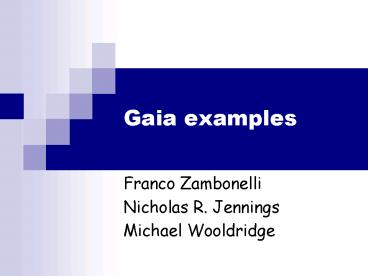Gaia examples PowerPoint PPT Presentation
1 / 36
Title: Gaia examples
1
Gaia examples
- Franco Zambonelli
- Nicholas R. Jennings
- Michael Wooldridge
2
Gaia process
3
Manufacturing Pipeline
- Pipeline in which items are transformed or
augmented (e.g., a pipeline in which metal items
are painted) - Different agents may be devoted to the control of
different stages of the pipeline - The role of each agent is that of stage
controller - Agents need to sense and effect a portion of the
environment
4
Gaia analysis models
- The organizations composition
- The environmental model
- The preliminary roles model
- The preliminary interaction model
- The rules that the organization should respect
and enforce in its global behaviour
5
Organization composition
6
Organizational Structures
- Master-slave
- Peer-to-peer
- Hierarchical
7
pipeline collective of peers
8
pipeline hierarchical organization
9
Environment modeling
- What are the environmental resources that agents
can effectively sense and effect? - It may be the case that no sensors exist to
effectively evaluate the quality parameters - How should the agent perceive the environment?
- The choice may depend on whether sensors are
passive or active - What in the existing scenario should be
characterized as part of the environment? - e.g., computer based sensors
10
manufacturing pipeline environment
11
Environmental Model
12
Organizational Rules
- Constraints that the actual organization, once
defined, will have to respect - In the manufacturing pipeline, all the different
stages must maintain the same speed of flow of
items in the pipeline
13
Preliminary Role Model
- Roles cannot be completed at this stage
- PR STAGE1, STAGE2, ..., STAGEN.
- Permissions
14
Environment-Preliminary Roles
15
Responsibilities
- Determine the expected behavior of a role
- Two types
- liveness properties (something good happens)
- safety properties (nothing bad happens)
- Specified using Temporal Logic
- Liveness expressions
16
Operators for liveness expressions
17
Liveness example
STAGEi consists of continuously executing an
indefinite number of times the activity
MonitorFluxi-1, to continuously check the flux
of incoming items, and to be possibly sometimes
interrupted and followed by the execution of the
protocols ReduceSpeed and OKReduceSpeed
18
Safety example
Ensure that the flux of items exceeds for no more
than a given threshold Ti (and possibly for no
more than a short time interval) that it is able
to process
19
Protocols
- Institutionalized patterns of interaction
- Protocols attributes
- protocol name
- initiator the role(s) responsible for starting
the interaction - partner the responder role(s) with which the
initiator interacts - inputs information used by the role initiator
- outputs information supplied by the protocol
responder - description textual description
20
ReduceSpeed protocol
21
Resuming roles
22
Architectural design models
- organizational structure in terms of its topology
and control regime - role and interaction models
23
Choosing the Org. Structure
24
In the pipeline example
OR
25
Completion of Role and Interaction Models
- defining all the activities
- as well as its liveness and safety
responsibilities - defining organizational roles
- those whose presence was not identified in the
analysis - completing the definition of the protocols
- by specifying which roles the protocol will
involve - defining organizational protocols
26
Completion of the ReduceSpeed protocol
27
Detailed design models
- Agent model
- Roles per agent
- agent classes
- agent instances
- Services model
- coherent blocks of activity in which an agent
will be engaged
28
Example 2 Conference Management
- submission phase authors send papers, and are
informed that their papers have been received - review phase the PC has to review the papers
contacting potential referees and asking them to
review a number of the papers (possibly by
bidding on papers) - final phase authors need to be notified of
decisions and, in case of acceptance, must be
asked to produce a revised version of their
papers. The publisher has to collect these final
versions and print the proceedings.
29
Overall organization
30
Environmental model
all papers submitted for review
reviews for the submitted papers
31
Preliminary roles
- REVIEWCATCHER selecting reviewers and assigning
papers to them - REVIEWER reviewer in charge of filling review
forms for assigned papers - REVIEWCOLLECTOR role in charge of collecting and
ranking the reviews - DOPROGRAM role of finalizing the technical
programme
32
REVIEWER role
Permissions
Responsibilities
33
REVIEWER schema
34
ReceivePaper preliminary protocol
35
Architectural design
36
Agent design
PC Chair
1
ReviewCatcher
ReviewCollector

